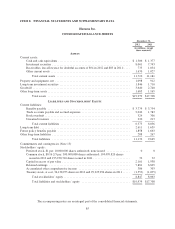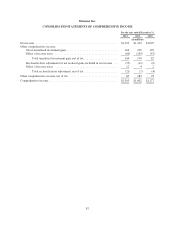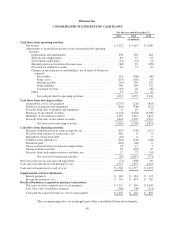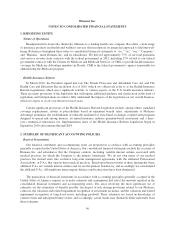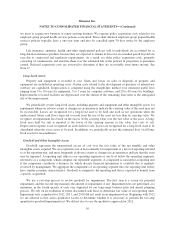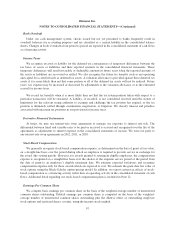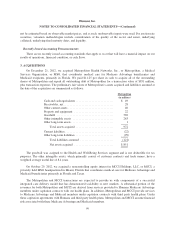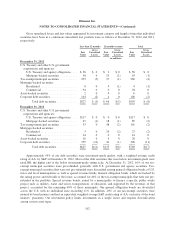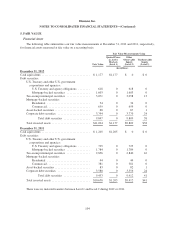Humana 2012 Annual Report Download - page 105
Download and view the complete annual report
Please find page 105 of the 2012 Humana annual report below. You can navigate through the pages in the report by either clicking on the pages listed below, or by using the keyword search tool below to find specific information within the annual report.Humana Inc.
NOTES TO CONSOLIDATED FINANCIAL STATEMENTS—(Continued)
we incur to acquire new business or renew existing business. We expense policy acquisition costs related to our
employer-group prepaid health services policies as incurred. These short-duration employer-group prepaid health
services policies typically have a one-year term and may be cancelled upon 30 days notice by the employer
group.
Life insurance, annuities, health and other supplemental policies sold to individuals are accounted for as
long-duration insurance products because they are expected to remain in force for an extended period beyond one
year due to contractual and regulatory requirements.As a result, we defer policy acquisition costs, primarily
consisting of commissions, and amortize them over the estimated life of the policies in proportion to premiums
earned. Deferred acquisition costs are reviewed to determine if they are recoverable from future income. See
Note 17.
Long-Lived Assets
Property and equipment is recorded at cost. Gains and losses on sales or disposals of property and
equipment are included in operating costs. Certain costs related to the development or purchase of internal-use
software are capitalized. Depreciation is computed using the straight-line method over estimated useful lives
ranging from 3 to 10 years for equipment, 3 to 7 years for computer software, and 20 to 40 years for buildings.
Improvements to leased facilities are depreciated over the shorter of the remaining lease term or the anticipated
life of the improvement.
We periodically review long-lived assets, including property and equipment and other intangible assets, for
impairment whenever adverse events or changes in circumstances indicate the carrying value of the asset may not
be recoverable. Losses are recognized for a long-lived asset to be held and used in our operations when the
undiscounted future cash flows expected to result from the use of the asset are less than its carrying value. We
recognize an impairment loss based on the excess of the carrying value over the fair value of the asset. A long-
lived asset held for sale is reported at the lower of the carrying amount or fair value less costs to sell.
Depreciation expense is not recognized on assets held for sale. Losses are recognized for a long-lived asset to be
abandoned when the asset ceases to be used. In addition, we periodically review the estimated lives of all long-
lived assets for reasonableness.
Goodwill and Other Intangible Assets
Goodwill represents the unamortized excess of cost over the fair value of the net tangible and other
intangible assets acquired. We are required to test at least annually for impairment at a level of reporting referred
to as the reporting unit, and more frequently if adverse events or changes in circumstances indicate that the asset
may be impaired. A reporting unit either is our operating segments or one level below the operating segments,
referred to as a component, which comprise our reportable segments. A component is considered a reporting unit
if the component constitutes a business for which discrete financial information is available that is regularly
reviewed by management. We aggregate the components of an operating segment into one reporting unit if they
have similar economic characteristics. Goodwill is assigned to the reporting unit that is expected to benefit from
a specific acquisition.
We use a two-step process to review goodwill for impairment. The first step is a screen for potential
impairment, and the second step measures the amount of impairment, if any. Impairment tests are performed, at a
minimum, in the fourth quarter of each year supported by our long-range business plan and annual planning
process. We rely on an evaluation of future discounted cash flows to determine fair value of our reporting units.
Impairment tests completed for 2012, 2011, and 2010 did not result in an impairment loss. Beginning with 2012
we are allowed to first assess qualitative factors to determine whether it is necessary to perform the two-step
quantitative goodwill impairment test. We did not elect to use the qualitative approach for 2012.
95


